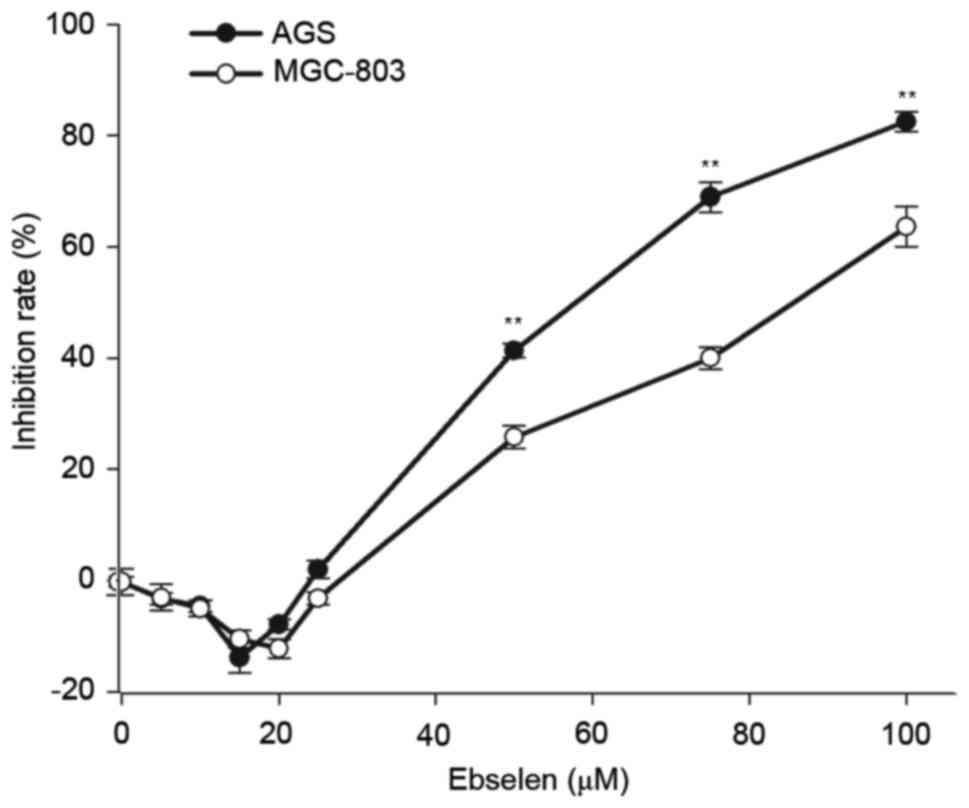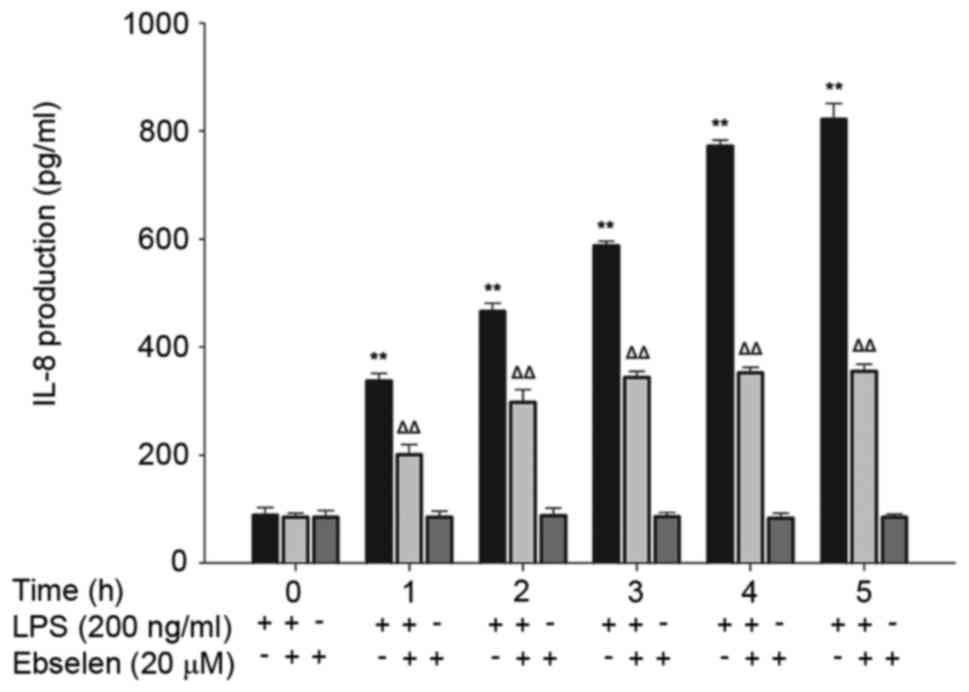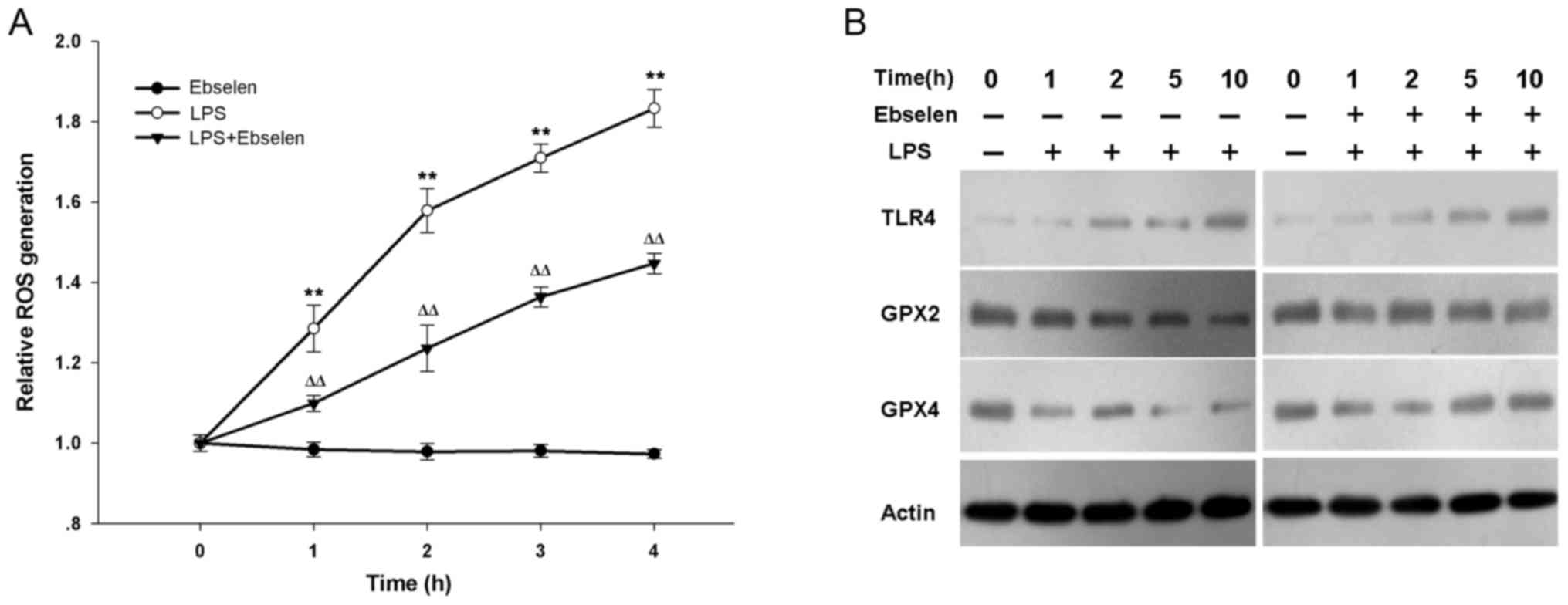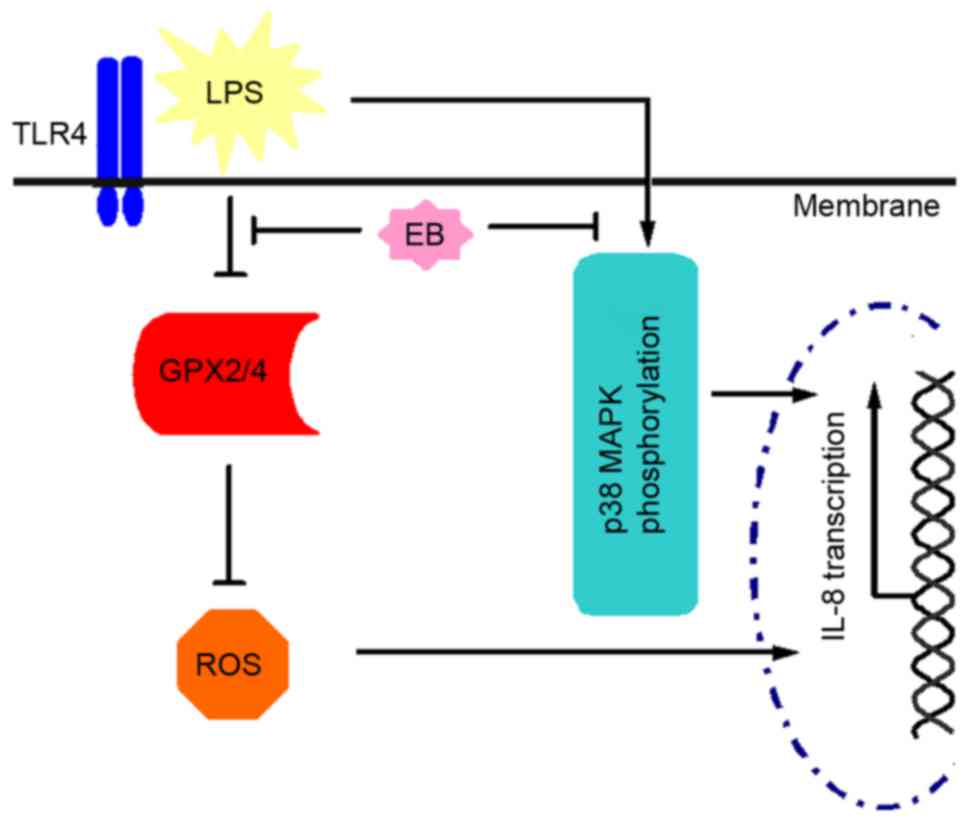Ebselen suppresses inflammation induced by Helicobacter pylori lipopolysaccharide via the p38 mitogen-activated protein kinase signaling pathway
- Authors:
- Published online on: February 27, 2018 https://doi.org/10.3892/mmr.2018.8641
- Pages: 6847-6851
Abstract
Introduction
A previous epidemiological study determined that Helicobacter pylori infection may be associated with chronic gastritis (CG), peptic ulcers (PU) and other gastric diseases (1). The International Agency for Research on Cancer officially recognized H. pylori as an oncogenic factor in patients with human gastric cancer (GC) (2). H. pylori is a microaerophilic Gram-negative bacterium, and H. pylori lipopolysaccharides (LPS) are responsible for the toxicity and contribute to the pathogenesis of CG, PU and GC. However, H. pylori LPS has several unique characteristics, including fewer fatty acid residues and absence of 4-phosphate groups; therefore, it has a distinctive activity by induction of cytokines (3,4). Exposure to H. pylori LPS leads to a marked increase in NO and proinflammatory cytokine levels, including interleukin (IL)-8 and toll-like receptor (TLR4) in gastric mucosa (5,6).
Ebselen [2-phenyl-1, 2-benzisoselenazol-3 (2H)-one] is a seleno-organic compound that has an activity similar to glutathione peroxidase (GPX). A previous study identified that ebselen may have antioxidant and anti-inflammatory activity (7), while another determined that ebselen may inhibit airway inflammation induced by inhalational LPS (8). However, the underlying molecular mechanism of its action remains to be elucidated.
The aim of the present study was to investigate the effect of ebselen on inflammation mediated by H. pylori LPS in vitro and to determine the underlying molecular mechanisms. The effect of ebselen on proliferation and migration of GC cells was investigated in vitro. The findings of the present study may aid in the identification of the possible association between ebselen and H. pylori LPS-induced inflammation in GC cells.
Materials and methods
Cell culture
Human GC cell lines AGS and MGC-803 were obtained from the Shanghai Institute of Biochemistry and Cell Biology, Chinese Academy of Sciences (Shanghai, China). Cells at a density of 1×106/ml were cultured in 25 cm2 cell culture flasks at 37°C in a humidified atmosphere of 5% CO2 with RPMI-1640 (Thermo Fisher Scientific, Inc., Waltham, MA, USA) supplemented with 10% fetal calf serum (FCS; Gibco; Thermo Fisher Scientific, Inc.) with 50 U/ml penicillin and 50 µg/ml streptomycin.
Extraction of LPS
LPS was extracted using hot phenol-water extraction, as previously described (9). A suspension of 500 mg biomass in 50 ml distilled water was mixed with 50 ml 90% phenol and mixed at 68°C for 20 min. The mixture was subsequently cooled to 4°C and centrifuged at 2,800 × g 4°C for 1 h, the resulting supernatant was separated. Subsequently, the phenol layer was extracted with 50 ml distilled water. Pooled supernatants in the aqueous phase were purified by dialysis using cellulose membranes for 24 h, following centrifugation at 2,800 × g, 4 times for 30 min the aqueous phase was separated. Crude LPS was resuspended in phosphate buffer containing 10 µg/ml deoxyribonuclease and 100 µg/ml ribonuclease. The solution was incubated for 16 h at 37°C and 750 ml 90% phenol in distilled water was added. Following dialysis for 10 min, the solution was centrifuged at 4,500 × g at 4°C for 30 min and the aqueous phase was separated and maintained at −20°C.
Analysis of cell viability
Cell viability was quantified using the Cell Counting Kit (CCK)-8 (Dojindo Molecular Technologies, Inc., Kumamoto, Japan), which determined the number of viable cells based on the reduction of water-soluble formazan by the dehydrogenases present in viable cells. Cells were seeded at a density of 2×104/well in 96-well plates, with 100 µl medium/well and were incubated with 0, 5, 10, 15, 20, 25, 50, 75, and 100 µmol/l ebselen (Sigma-Aldrich, Merck Millipore, Darmstadt, Germany) for 24 h. Three wells of each group were used in repeat experiments. After 24 h post-attachment, 10 µl WST-8 [2-(2-methoxy-4-nitrophenyl)-3-(4-nitrophenyl)-5-(2,4-disulfophenyl)-2H-tetrazolium] solution was added to each well and cells were incubated at 37°C for 1 h. Absorbance was read at 450 nm on a microplate reader (SpectraFluor; Tecan, Inc., Zürich, Switzerland).
Western blotting
Cells were seeded at a density of 2×106/well in 90-mm dishes, and 0 or 200 ng/ml LPS was added. The cells were subsequently incubated with or without 20 µmol/l ebselen for 10, 20, 30, 40, 50 min, 1, 2, 5 or 10 h. Total proteins were extracted by RIPA cell lysis buffer containing 1 mmol/l PMSF (Beyotime Institute of Biotechnology, Shanghai, China) with a centrifugation at 12,000 × g for 10 min at 4°C. The protein concentrations were determined using a BCA kit (Beyotime Institute of Biotechnology). A total of 50 mg protein per lane was electrophoresed on a 10% sodium dodecyl sulfate-polyacrylamide electrophoresis gel and transferred onto a nitrocellulose (NC) membrane. Following three washes with TBST (10 min each), the membrane was blocked by 5% non-fat milk for 1 h at room temperature. Then the membranes were incubated with the primary antibody [GPX2, cat. no. ab137431; 1:1,000; GPX4, cat. no. ab125066, 1:1,000; and TLR4, cat. no. ab22048, 1:1,000; all from Abcam, Cambridge, MA, USA; p38 mitogen-activated protein kinase (p38 MAPK), cat. no. 9212, 1:1,000; and phosphorylated (p)-p38 MAPK, cat. no. 4511, 1:1,000; both from Cell Signaling Technology, Inc., Danvers, MA, USA] at 4°C overnight. The membraned were washed with TBST for 3 times, 10 min each, incubated with secondary antibody [goat anti-rabbit IgG-peroxidase antibody; cat. no. A0545; Sigma-Aldrich; Merck KGaA, Darmstadt, Germany; goat anti-mouse IgG (Fc specific)-peroxidase antibody; cat. no. A0168; Sigma-Aldrich; Merck KGaA] with 1:5,000 dilution at room temperature for 1 h. The membranes were subsequently washed with TBST for 3 times, 10 min each, the membrane was washed three times with TBST and detected with enhanced chemiluminescence (Beyotime Institute of Biotechnology, Haimen, China).
ELISA
Cells were seeded at a density of 2×104/well in 96-well plates and cultured overnight, followed by serum starvation for 24 h prior to every experiment. Cells were incubated with 200 or 200 ng/ml LPS and 20 µmol/l ebselen for 1–5 h. The supernatants obtained by centrifugation at 2,000 × g, 4°C for 20 min were quantified using the human IL-8 ELISA kit according to the manufacturer's protocol (R&D Systems, Inc., Minneapolis, MN, USA).
Quantification of reactive oxygen species (ROS) generation
Intracellular ROS accumulation was detected using fluorescence microscopy. Cells were plated at a density of 2×104/well in a 96-well plate and cultured in RPMI-1640 medium supplemented with 10% FCS. The culture medium was renewed when the cells reached 80% confluence. Cells were treated with 200 or 200 ng/ml LPS and 20 µmol/l ebselen at 37°C for 1–4 h. The supernatants were quantified using the Cellular ROS Detection Assay kit (Thermo Fisher Scientific, Inc.).
Statistical analysis
Data are expressed as mean ± standard deviation. CCK-8 data was analyzed using two-way analysis of variance (ANOVA) followed by the Dunnett's test. Western blot analysis, ROS levels and IL-8 assays, were analyzed using one-way ANOVA followed by a Newman-Keuls post hoc test. P<0.05 was considered to indicate a statistically significant difference.
Results
Ebselen modulates the viability of GC cells
In order to determine the effect of ebselen on GC cell viability, AGS and MGC-803 cells were treated with various concentrations of ebselen for 24 h, before the cell viability rate was detected by CCK-8 assay. The assay revealed that different concentrations of ebselen produced different effects on GC cell viability (F=18.204; P<0.001; Fig. 1). Ebselen promoted cell viability at low concentrations, whereas at high concentrations it significantly inhibited cell growth. The effect on cell viability was dose-dependent, with a minimal effect at 20 µmol/l; therefore, this concentration was selected for subsequent experiments.
Ebselen inhibits IL-8 production induced by H. pylori LPS
Production of IL-8 in AGS cells treated with 0 and 200 ng/ml H. pylori LPS for 0–4 h was detected in the absence or presence of 20 µmol/l ebselen (Fig. 2). Ebselen treatment did not result in any significant differences in IL-8 release at any time point compared with the 0 h control (Fig. 2). Stimulation with H. pylori LPS significantly increased IL-8 production in a time-dependent manner (P<0.01; Fig. 2); however, this effect was suppressed by ebselen treatment (Fig. 2). The 1 h treatment with 200 ng/ml H. pylori LPS enhanced the production of IL-8 in AGS cells in a time-dependent manner. Simultaneous addition of 20 µmol/l ebselen inhibited the production of IL-8 in HP-LPS promoted cells. However, in a certain period of time (3 h), this effect achieved leveled off.
Ebselen inhibits ROS enhanced by H. pylori LPS via activation of GPX signaling
The underlying mechanism that affects IL-8 production was then investigated. ROS are essential components of the innate immune response against intracellular bacteria, and are closely associated with IL-8. Therefore, the effect of ebselen on H. pylori LPS-induced ROS was investigated. The levels of ROS generation in ebselen-treated, LPS-treated, and LPS+ebselen-treated AGS cells was measured (Fig. 3A). LPS-treated cells produced more ROS at each time point from 1 h than ebselen-treated and LPS+ebselen-treated cells (Fig. 3A; LPS vs. ebselen, P=0.001 at 1 h, P<0.001 at 2, 3 and 4 h; LPS vs. LPS+ebselen, P=0.006 at 1 h, P=0.002 at 2 h, P<0.001 at 3 and 4 h). Ebselen treatment alone did not inhibit spontaneous ROS generation with increased treatment time (Fig. 3A). In order to determine whether ebselen affected TLR or GPX signaling, the effect of LPS and ebselen on AGS cells was investigated (Fig. 3B). H. pylori LPS treatment visibly increased TLR4 protein expression levels with time in AGS cells; however, treatment with ebselen+LPS had no significant effect on TLR4 expression compared with LPS alone (Fig. 3B). H. pylori LPS treatment alone reduced GPX2 and GPX4 expression, however co-treatment with ebselen treatment prevented this effect (Fig. 3B).
Ebselen blocks H. pylori LPS-induced phosphorylation of p38 MAPK
The effect of ebselen on p-p38 MAPK expression levels induced by H. pylori LPS treatment was also investigated. Western blotting confirmed that phosphorylation of p38 MAPK was significantly greater in AGS cells treated with LPS compared with cells treated with LPS+ebselen (P<0.01; Fig. 4). These findings suggested that ebselen inhibited the phosphorylation of p38 MAPK induced by H. pylori LPS treatment and may be capable of reducing IL-8 expression levels by inhibiting the phosphorylation of p38 MAPK.
Discussion
Several toxic substances associated with H. pylori, including LPS, perform a key role in gastroduodenal diseases. Cytokine induction is triggered by a ROS signal, but the identity of the specific TLR responsible for the recognition of H. pylori LPS remains to be determined. Previous studies have implicated TLR4 (10–13), whereas others have suggested a role for TLR2, therefore the exact mechanism is not fully understood. Previous studies have reported the anti-inflammatory activity of ebselen, particularly in human cancer cells (14,15). Ebselen affects extracellular signal-regulated kinase (ERK), c-Jun N-terminal kinase (JNK) and p38 MAPK signaling which are involved in various cellular processes, such as proliferation, differentiation and apoptosis (16–19). The impact of ebselen on these pathways is currently under investigation.
The present study determined that H. pylori LPS was important for ROS and IL-8 production in GC cells. LPS significantly increased ROS and IL-8 production, suggesting that it is a major virulence factor for H. pylori-associated mucosal inflammation. This effect was inhibited by the anti-inflammatory drug ebselen. Additionally, the present study determined that ebselen had a dose-dependent effect on GC cell viability. In AGS cells, TLR4 expression was increased, but GPX2 and GPX4 expression was decreased by H. pylori LPS. In further analysis, ebselen was demonstrated to inhibit the H. pylori LPS-induced downregulation of GPX2/4 expression. However, ebselen treatment did not affect TLR4 expression, suggesting that ebselen may inhibit H. pylori LPS-induced ROS production via GPX2/4 expression as opposed to TLR4 signaling. This may be due to the fact that ebselen acts as an oxidant at redox-modulatory sites, which mimics the activity of endogenous GPX, therefore partially restores GPX antioxidant capacity (20,21). Furthermore, the present study demonstrated that phosphorylation of p38 MAPK was significantly increased following H. pylori LPS treatment and that LPS-induced phosphorylation of p38 MAPK was inhibited by treatment with ebselen. Therefore, the present study hypothesizes that ebselen disrupted the H. pylori LPS-activated ROS/IL-8 pathway by restoring GPX2/4 expression and blocking the generation of IL-8 by inhibiting phosphorylation of p38 MAPK, as presented in Fig. 5.
The present study revealed that the anti-inflammatory activity of ebselen may be associated with its antioxidative properties. Therefore, ebselen may be a potential therapeutic agent to mediate H. pylori LPS-induced cell damage.
Acknowledgements
Not applicable.
Funding
The present study was supported by grants from the National Natural Science Foundation of China (grant nos. 81472242 and 81570549), Shanghai Municipal Health Bureau Key Disciplines Grant (grant no. ZK2015A24), Natural Science Foundation of the Science and Technology Commission of Shanghai Municipality, (grant nos. 14ZR1431600 and 14411973700) and the Shanghai Municipal Health Bureau (grant no. 20134100).
Availability of data and materials
All data generated or analyzed during this study are included in this published article.
Authors' contributions
MS and YW conceived and designed the experiments, LX and CG performed the experiments, GL and JW analyzed the data, TW and WM contributed the reagents and materials, and LX wrote the manuscript. All authors read and approved the final manuscript.
Ethics approval and consent to participate
Not applicable.
Consent for publication
Not applicable.
Competing interests
The authors declare that they have no competing interests.
References
|
Peek RM Jr and Blaser MJ: Helicobacter pylori and gastrointestinal tract adenocarcinomas. Nat Rev Cancer. 2:28–37. 2002. View Article : Google Scholar : PubMed/NCBI | |
|
Schistosomes, liver flukes and Helicobacter pylori. IARC working group on the evaluation of carcinogenic risks to humans; Lyon, 7–14 June 1994. IARC Monogr Eval Carcinog Risks Hum. 61:1–241. 1994.PubMed/NCBI | |
|
Hynes SO, Ferris JA, Szponar B, Wadström T, Fox JG, O'Rourke J, Larsson L, Yaquian E, Ljungh A, Clyne M, et al: Comparative chemical and biological characterization of the lipopolysaccharides of gastric and enterohepatic Helicobacter. Helicobacter. 9:313–323. 2004. View Article : Google Scholar : PubMed/NCBI | |
|
Esmaeilli D, Mobarez AM, Salmanian AH and Hosseini AZ: Bioactivity and immunological evaluation of LPS from different serotypes of Helicobacter pylori. Iran J Microbio. 5:142–146. 2013. | |
|
Ogawa T, Asai Y, Sakai Y, Oikawa M, Fukase K, Suda Y, Kusumoto S and Tamura T: Endotoxic and immunobiological activities of a chemically synthesized lipid A of Helicobacter pylori strain 206-1. FEMS Immunol Med Microbiol. 36:1–7. 2003. View Article : Google Scholar : PubMed/NCBI | |
|
Lepper PM, Triantafilou M, Schumann C, Schneider EM and Triantafilou K: Lipopolysaccharides from Helicobacter pylori can act as antagonists for Toll-like receptor 4. Cell Microbiol. 7:519–528. 2005. View Article : Google Scholar : PubMed/NCBI | |
|
Marthandan S, Hyland P, Pawelec G and Barnett Y: An investigation of the effects of the antioxidants, ebselen or N-acetyl cysteine on human peripheral blood mononuclear cells and T cells. Immun Ageing. 10:72013. View Article : Google Scholar : PubMed/NCBI | |
|
Haddad el-B, McCluskie K, Birrell MA, Dabrowski D, Pecoraro M, Underwood S, Chen B, De Sanctis GT, Webber SE, Foster ML and Belvisi MG: Differential effects of ebselen on neutrophil recruitment, chemokine and inflammatory mediator expression in a rat model of lipopolysaccharide-induced pulmonary inflammation. J Immunol. 169:974–982. 2002. View Article : Google Scholar : PubMed/NCBI | |
|
Bernardová K, Babica P, Marsálek B and Bláha L: Isolation and endotoxin activities of lipopolysaccharides from cyanobacterial cultures and complex water blooms and comparison with the effects of heterotrophic bacteria and green alga. J Appl Toxicol. 28:72–77. 2008. View Article : Google Scholar : PubMed/NCBI | |
|
Uno K, Kato K, Atsumi T, Suzuki T, Yoshitake J, Morita H, Ohara S, Kotake Y, Shimosegawa T and Yoshimura T: Toll-like receptor (TLR)2 induced through TLR4 signaling initiated by Helicobacter pylori cooperatively amplifies iNOS induction in gastric epithelial cells. Am J Physiol Gastrointest Liver Physiol. 293:G1004–G1012. 2007. View Article : Google Scholar : PubMed/NCBI | |
|
Chochi K, Ichikura T, Kinoshita M, Majima T, Shinomiya N, Tsujimoto H, Kawabata T, Sugasawa H, Ono S, Seki S and Mochizuki H: Helicobacter pylori augments growth of gastric cancers via the lipopolysaccharide-toll-like receptor 4 patyway whereas its lipopolysaccharide attenuates antitumor activities of human mononuclear cells. Clin Cancer Res. 14:2909–2917. 2008. View Article : Google Scholar : PubMed/NCBI | |
|
Kawahara T, Teshima S, Oka A, Sugiyama T, Kishi K and Rokutan K: Type I Helicobacter pylori lipopolysaccharice stimulates toll-like receptor 4 and activates mitogen oxidase 1 in gastric pit cell. Infect Immun. 69:4382–4389. 2001. View Article : Google Scholar : PubMed/NCBI | |
|
Smith SM, Moran AP, Duggan SP, Ahmed SE, Mohamed AS, Windle HJ, O'Neill LA and Kelleher DP: Tribbles 3: A novel regulator of TLR2-mediated signaling in response to Helicobacter pylori lipopolysaccharide. J Immunol. 186:2462–2471. 2011. View Article : Google Scholar : PubMed/NCBI | |
|
Azad GK, Singh V, Mandal P, Singh P, Golla U, Baranwal S, Chauhan S and Tomar RS: Ebselen induces reactive oxygen species (ROS)-mediated cytotoxicity in Saccharomyces cerevisiae with inhibition of glutamate dehydrogenase being a target. FEBS Open Bio. 4:77–89. 2014. View Article : Google Scholar : PubMed/NCBI | |
|
Parnham MJ and Sies H: The early research and development of ebselen. Biochem Pharmacol. 86:1248–1253. 2013. View Article : Google Scholar : PubMed/NCBI | |
|
Yoshizumi M, Fujita Y, Izawa Y, Suzaki Y, Kyaw M, Ali N, Tsuchiya K, Kagami S, Yano S, Sone S and Tamaki T: Ebselen inhibits tumor necrosis factor-alpha-induced c-Jun N-terminal kinase activation and adhesion molecule expression in endothelial cells. Exp Cell Res. 292:1–10. 2004. View Article : Google Scholar : PubMed/NCBI | |
|
Yoshizumi M, Kogame T, Suzaki Y, Fujita Y, Kyaw M, Kirima K, Ishizawa K, Tsuchiya K, Kagami S and Tamaki T: Ebselen attenuates oxidative stress-induced apoptosis via the inhibition of the c-Jun N-terminal kinase and activator protein-1 signalling pathway in PC12 cells. Br J Pharmacol. 136:1023–1032. 2002. View Article : Google Scholar : PubMed/NCBI | |
|
Sharma V, Tewari R, Sk UH, Joseph C and Sen E: Ebselen sensitizes glioblastoma cells to tumor necrosis Factor (TNFalpha)-induced apoptosis through two distinct pathways involving NF-kappaB downregulation and Fas-mediated formation of death inducing signaling complex. Int J Cancer. 123:2204–2212. 2008. View Article : Google Scholar : PubMed/NCBI | |
|
Yang CF, Shen HM and Ong CN: Ebselen induces apoptosis in HepG-2 cells through rapid depletion of intracellular thiols. Arch Biochem Biophys. 374:142–152. 2000. View Article : Google Scholar : PubMed/NCBI | |
|
Luo Z, Liang L, Sheng J, Pang Y, Li J, Huang L and Li X: Synthesis and biological evaluation of a new series of ebselen derivatives as glutathione peroxidase (GPX) mimics and cholinesterase inhibitors against Alzheimer's disease. Bioorg Med Chem. 22:1355–1361. 2014. View Article : Google Scholar : PubMed/NCBI | |
|
Wang X, Yun JW and Lei XG: Glutathione peroxidase mimic ebselen improves glucose-stimulated insulin secretion in murine islets. Antioxid Redox Signal. 20:191–203. 2014. View Article : Google Scholar : PubMed/NCBI |














